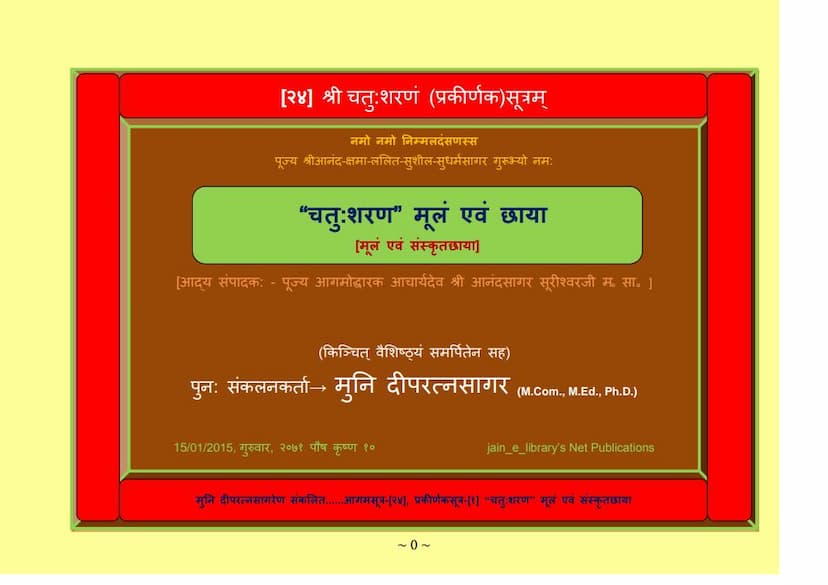Aagam 24 CHATU SHARAN Moolam Evam Vrutti
Added to library: September 1, 2025

Summary
This is a comprehensive summary of the Jain text "Aagam 24 CHATU SHARAN Moolam evam Vrutti" by Dipratnasagar and Deepratnasagar, based on the provided pages:
Book Title: Aagam 24 CHATU SHARAN Moolam evam Vrutti (Jain Agam 24: Chatur Sharan - Original Text and Commentary)
Author(s): Munishri Dipratnasagar (Compiler and Re-editor), Poojya Agamoddharak Acharya Shri Anand Sagar Surishwarji (Original Editor)
Publisher: Deepratnasagar (as compiled by Munishri Dipratnasagar)
Catalog Link: https://jainqq.org/explore/004124/1
Overall Purpose and Nature of the Text:
The book "Chatuh Sharan" (Four Refuges) is identified as a "Prakirnak Sutra" (miscellaneous or supplementary scripture) within the Jain Agamas, specifically designated as Agam 24. The primary aim of this publication is to present the original text of the Chatur Sharan scripture along with its Sanskrit translation/commentary (Moolam evam Sanskrit Chhaya). The current edition, compiled by Munishri Dipratnasagar, is a re-publication based on an earlier version.
Historical Context and Evolution of the Publication:
- Original Publication (1927): The text was first published in 1927 (Vikram Samvat 1983) by the Agamodaya Samiti. The original editor was the revered Agamoddharak Acharya Shri Anand Sagar Surishwarji (also known as Sagaranand Suriji). This initial publication contained 10 Prakirnak sutras.
- Subsequent Reprints and Issues: The introduction by Munishri Dipratnasagar highlights a concern about how this original edition was subsequently reprinted by others. Some allegedly reproduced it by simply "offsetting" the original, adding their names and publishing house names without significant new contribution. In some cases, the original editor's and publisher's names were removed, and credit was solely attributed to the new individuals.
- Munishri Dipratnasagar's Motivation and Approach: Munishri Dipratnasagar undertook this re-compilation out of respect for the original work, the legacy of Acharya Sagaranand Suriji, and a desire to serve the Agamas. His effort involved:
- Scanning the Original: He had the original printing scanned.
- Creating a Special Format: A new format was designed for clarity. The original text of Acharya Sagaranand Suriji's edition is placed centrally on each page. The Agam's name and the Sutra/Gatha number are placed at the top. The left side includes the Agam's sequence number and the current work's sequence number, along with a "Deep Anukram" (Dip Index) to facilitate access across various Jain Agam publications.
- Differentiating Sutras and Gathas: Where a Sutra is presented, it's enclosed in parentheses. Where a Gatha is presented, it's marked with lines or the word "Gatha."
- Creating an Index: A comprehensive index (Anukramanika) has been created, listing each study (Adhyayan) and subject with corresponding page numbers, making it easier for scholars to find specific topics.
- Adding Footnotes: Important footnotes are provided at the bottom of many pages to clarify specific subject matter, point out printing errors from the original, or correct numbering issues.
- Digital Publication: This edition is presented as an "Internet Publication" by jain_e_library.org, aiming for wider and more accessible reach globally. Future printing is also envisioned.
Content and Structure of the "Chatuh Sharan" Scripture:
The provided pages showcase the progression of the Chatur Sharan scripture. It appears to be a poetic or lyrical exposition, presented in Prakrit with a Sanskrit translation. The content focuses on:
- The concept of "Chatuh Sharan" (Four Refuges): This central theme refers to taking refuge in specific entities for spiritual liberation. The scripture explicitly names these four refuges:
- Arhant: The perfected beings, worshipped and revered.
- Siddha: The liberated souls who have attained omniscience and bliss.
- Sadhu (Acharya, Upadhyaya, Sadhu): The monks and spiritual preceptors.
- Dharma: The path of righteousness and liberation as taught by the Tirthankaras.
- Explanations and Glorification: The text elaborately explains the qualities and significance of each of these four refuges. It uses devotional language and praises the virtues of Arhantas, Siddhas, and Sadhus.
- Key Themes and Practices Mentioned:
- Six Essential Duties (Shat Avashyak): The text mentions the six essential daily practices for Jain ascetics, including Samayika (equanimity), Stuti (praise), Vandan (obeisance), Pratikraman (atonement), Kayotsarga (abandonment of the body), and Tapa (penance). The scripture details how these practices contribute to the purification of conduct.
- Penitence and Atonement (Pratikraman): The importance of acknowledging and atoning for mistakes and transgressions is emphasized.
- Virtue and Merit (Guna Dharana, Sukrita): The cultivation and retention of virtues and good deeds are highlighted.
- Repentance for Sins (Dushkrit Garha): The text includes a section dedicated to regretting and confessing past wrongdoings.
- Appreciation of Good Deeds (Sukrita Anumodana): The practice of rejoicing in and appreciating the good deeds of oneself and others is encouraged.
- Spiritual Practices: Concepts like meditation, devotion, and adhering to vows are implicitly or explicitly present.
- Addressing Ignorance and Attachment: The scripture speaks against ignorance, attachment to worldly pleasures, and the cycle of birth and death.
Specific Content Highlighted in the Pages:
- Page 1-4: Introduction, editorial notes, historical context, and acknowledgments.
- Page 5-11: The core of the "Chatuh Sharan" scripture, presenting the verses in Prakrit and Sanskrit, detailing the significance of the six Avashyakas and the qualities of Arhantas and Siddhas. It outlines the process of seeking refuge.
- Page 12-13: Continues the exposition on "Dushkrit Garha" (regret for sins) and "Sukrita Anumodana" (appreciation of good deeds), concluding the commentary on the Chatur Sharan scripture with a summary and final verses.
Overall Significance:
The book "Aagam 24 CHATU SHARAN Moolam evam Vrutti" is a valuable resource for understanding a specific Jain scripture. It emphasizes the fundamental Jain principle of taking refuge in the Triratna (Right Faith, Right Knowledge, Right Conduct) embodied by the Arhant, Siddha, and Sadhu, and the Dharma itself, as the path to liberation from the cycle of birth and death. The re-compilation by Munishri Dipratnasagar ensures the preservation and accessibility of this important text, while also acknowledging and respecting its original scholarly origins.